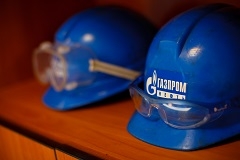- Home page /
- News /
- Company news /
- Gazprom Neft completes well tests to look for shale oil at...
Gazprom Neft completes well tests to look for shale oil at Krasnoleninskoye field
05.04.2013

Gazprom Neft has completed drilling of the first prospecting and appraisal well for the purpose of commercial analysis and testing of the Bazhenovsky-Abalaksky formation in the Palianovskaya area of Krasnoleninskoye field, which is being developed by Gazpromneft-Khantos. The well produced a gushing flow of gas-oil mixture at a rate of 80 cubic meters (2,825 cubic feet) per day. Core sample analysis and testing of pay formations confirm that there are highly conductive channels in the shale oil formations.
Gazprom Neft specialists have also looked at the results of testing and operation of the earlier drilled wells that hit the Bazhenovskaya suite and are located relatively close to Krasnoleninskoye field in Khanty-Mansi Autonomous Okrug-Yugra. At present, the company is working to create a conceptual geological model of shale oil deposits and is determining the area for drilling new well cluster. Gazprom Neft plans to complete the project documentation for commercial development of shale oil in the Palianovskaya area of Krasnoleninskoye field by the summer of 2013.
Assessment of the potential of Bazhenovsky-Abalaksky formation in Palianovskaya area is Gazprom Neft’s second project which looks into the possibilities of producing shale oil. The company is acquiring similar experience through Sàlym Petroleum Development (SPD), its joint venture with Shell. Specialists from Gazprom Neft, Shell, and SPD have drafted a road map that defines the stages in the development of the Bazhenovskaya suite at Verkhne-Salymskoye oilfield in Khanty-Mansi Autonomous Okrug-Yugra.
Shale oil is contained in the Bazhenovskaya, Abalakskaya, and Frolovskaya suites, rock formations in Western Siberia with super-low permeability and high level of oil saturation.
2-D and 3-D seismic surveys have been conducted in the Palianovskaya area, and shale oil reservoirs were discovered through the drilling of 25 exploration wells and 10 production wells.

